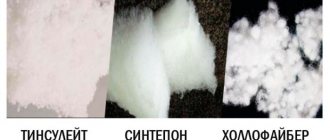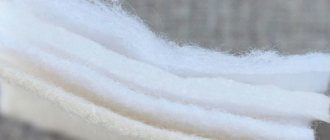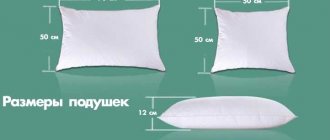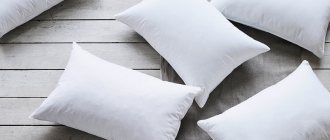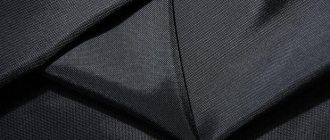Cause of occurrence and characteristics of the material
Bio-down dupont sorona was created from a biopolymer by two companies ZM Thinsulate, DuPont. The invention was discovered by accident. During the production process, a substance for adhesive tape was prepared. The synthetic material appeared due to errors. The quality of raw materials is constantly improving. It began to be used in the manufacture of outerwear.
When wondering what bio-down is, you need to know that it is an insulation material that contains constantly renewable natural elements. They undergo special processing. A patent has been received for the production process, which meets established standards.
The material is environmentally friendly. Regularly renews itself in the environment. The technological process is unique. During manufacturing, it was possible to reduce the consumption of extracted fuel. Energy consumption for the formation of bio-fluff is 30% lower compared to nylon. The amount of gases released is -63% less. For the results, the manufacturer was awarded a certificate.
History of creation and manufacturing technology
Sample of bio-down
Bio-down is a unique development of two world-famous companies DuPont and ZM Thinsulate. The material is based on a biopolymer, which was patented by the American and Japanese organizations DuPont and Sorona.
Like many other discoveries, the invention happened by accident. During production, a special mass was prepared to obtain adhesive tape. When the technological process took place, an error occurred, due to which a new synthetic material was obtained. Over time, bio-down was improved and began to be widely used in light industry.
Bio-fluff contains regularly renewable biological components that undergo special chemical treatment using patented technology. We can say that bio-fluff is the result of modern scientific research in the field of biotechnology.
Bio-down is an environmentally friendly material that is constantly renewed in the natural environment. For its preparation, a unique technology is used that reduces the consumption of fossil fuels. The substance promotes energy saving during the production process. Compared to the production of nylon, bio-fluff requires 30% less energy costs, and produces 63% less greenhouse gases. Thanks to these achievements, the manufacturing company even received an award in the field of green chemistry development.
Main characteristics
Buyers are often interested in whether bio-down is warm or not? The insulation is characterized by excellent thermal insulation performance.
There are both pros and cons to artificial down in jackets. After washing, the product dries completely in just a few hours. While winter outerwear with other types of insulation takes much longer to dry.
Bio-down insulation has other advantages:
- Long service period.
- Harmless. Does not cause allergic reactions.
- A light weight. The filler does not restrict body movements.
- The material does not absorb external odors.
- Plastic. Does not become thinner over time, creases do not appear.
- Can be washed in an automatic machine. Things do not change shape and are resistant to compaction and rolling.
- Fibers do not show through seams.
- Moisture resistant.
Useful
For those who are interested, what temperature is bio-down designed for? Answer, clothes can be worn at minus 40 degrees Celsius.
However, artificial down also has disadvantages:
- you can overheat in clothes;
- there are problems with removing sweat from the body;
- static electricity accumulates;
- the price is higher than that of natural analogues;
- raw materials are deformed when exposed to high temperatures near heaters or open fire.
Despite some disadvantages, down jackets with artificial down can be worn in unfavorable climatic conditions - severe frost or windy weather.
What types of fillers are there? How are they fundamentally different?
Types are divided into 2 groups: natural and artificial. Each has its own pros and cons.
The first group consists of natural fluff. It is a popular filler, where swan or goose down, as well as duck or eider down, are used as insulation.
The benefits of down are as follows:
- high heat saving ability
- softness
- ease
The disadvantages of natural down are:
- fragility
- special storage and cleaning conditions
- loss of shape
- possibility of allergic reactions
- high price
Natural down
Among artificial fillers, Thinsulate, which has caused a stir in the textile industry, stands out. From the name (thin-thin, insulation-thermal insulation, English) we get thin thermal insulation. Interestingly, this technology was first introduced in 1978 by the American, as part of the NASA program, as a material for astronaut suits. Consists of microfibers that are 50 times thinner than a human hair. Refers to materials with a high heat retention rate. At a certain density it can protect against temperatures down to -60°C, and is used to create high-quality mountaineering equipment. But let’s look further at the advantages related to outerwear itself.
Advantages of Thinsulate:
- unique thermoregulatory properties
- the lightest of all artificial fillers
- almost 2 times warmer than down
- hypoallergenic
- durable
- does not lose shape
- ecologically pure
- indispensable in regions with high humidity
- perfect for children's clothing
Disadvantage of Thinsulate:
- slightly higher price compared to other non-natural fillers.
Filler Thinsulate
Also among fillers with a high degree of thermal insulation is BioPooh Sustans, a patented biopolymer, a revolutionary technology from DuPont-Sorona (USA-Japan). The first high-tech material, partly composed of regularly renewable plant components. The process of creating this fiber is biologically friendly. In this regard, DuPont was awarded the Presidential Award in America for their contribution to the creation of environmentally friendly production.
The advantages of BioPooh are:
- ease
- softness
- elasticity and resilience
- innovative thermal insulation properties
- super strength
- looks beautiful, elegant and not too bulky
- Great for children's down jackets and overalls
- can be washed at home
- environmentally friendly material
Disadvantage of BioFuzz:
- in terms of thermal insulation properties it is close to natural down, that is, inferior to Thinsulate
BioDown SUSTANS
There are also many artificial fillers for down jackets that are already outdated and no longer relevant, such as padding polyester, synthetic padding, holofiber (fiberskin, fibertek, polyfiber) consisting of different shapes of polyester fibers. To provide thermal insulation comparable to bio-down and Thinsulate, they are required in larger volumes, so they make the product much heavier.
In general, now, having come to an outerwear store for such an irreplaceable item as a down jacket, we can already navigate what the different fillers are and make the right choice. Some are attracted by naturalness, others by a high degree of thermal insulation, and for others, price and practicality are more important. Winter is ahead, it’s worth meeting it prepared, and using the latest advances in science to warm yourself and enjoy this magical time of year in peace.
Bio-down and eco-down: which is better?
Many housewives are also interested in the questions of what is bio-down in a down jacket or what is eco-down? The first one is a soft and fluffy raw material with a biological base. It has a spherical and three-dimensional structure, reminiscent of real fluff. Main qualities: breathability, elasticity. Reminds me of silk. 50% more warm than natural down.
Ecopooh is an insulation material consisting of thin fibers that resembles synthetic fluff in quality.
There are also clothes on sale with Thinsulate filler. Skiers choose equipment made from this material because it is breathable and promotes normal perspiration. No greenhouse effect is created.
In comparison, which is better: fluff or thinsulate? It depends on the purpose of the outerwear. Down is suitable for everyday life. Fans of winter sports would be better off choosing something else.
Useful
In stores you can find clothes with a filler called orsotherm. It is manufactured using the latest improved technology. Consists of siliconized components and special additives. For those who are interested, what temperature can Orsotherm insulation be worn to? The answer is that thanks to the air that is between the fibers, in clothes with such a filler, the human body can retain heat even in extreme cold.
Purpose and scope
Bio-down in outerwear at low temperatures performs a protective function against frost and wind. The filler is used in the manufacture of:
- equipment for fishermen and hunters;
- equipment;
- travel sleeping bags and sports accessories;
- casual outerwear (pants, jackets);
- insulated suits for snowboarding and skiing.
The models are comfortable to move in. Thanks to the lightness and plasticity of the raw materials, manufacturers create attractive and stylish models.
Wash
How to wash bio-down so that the material does not deform? Before washing, rub off heavily soiled areas and stains with plain soap. You should follow the manufacturer's recommendations indicated on the label, which indicate how many degrees the water is heated to, as well as the number of revolutions.
Basic rules for machine washing regular bio-down clothing:
- the temperature regime is set no higher than 40 degrees Celsius;
- It is advisable to use the additional rinse function;
- the number of revolutions is no more than 600;
- to avoid white marks, use special liquid detergents;
- When rinsing, it is better to add conditioner to soften the material and extend its service life.
Housewives who are wondering whether it is possible to wash large items need to know that hand washing is allowed, since they do not fit in the machine. You should also follow the following recommendations:
- Contaminated areas are cleaned with a brush;
- clothes are washed so that the filling gets wet evenly;
- pour non-hot water into the container;
- rinse clothes at least twice.
When washing bio-down in outerwear, the temperature is set to the same as when washing in a washing machine - no higher than 40 degrees Celsius.
Useful
In order to dry clothes from a bio-down jacket or down jacket, it is laid out on a surface in a horizontal position. It is advisable to place a thick natural fabric (towel) where excess water will drain. The material should not fade. The products are periodically turned over. Beat the dried item well to evenly distribute the fiber in the middle.
After washing, things need to be dried in natural conditions. You can do this outdoors or in a ventilated area. Do not leave directly in the sun, too close to a heater or open fire.
Care tips
Natural down is a natural heat insulator in all weather conditions. Down is the most valuable layer of a bird's plumage and has unique properties - it is light, breathes freely and, thanks to its porous structure, absorbs a large volume of air. Natural down provides pleasant warmth, eliminating the danger of overheating and sweating.
FORBIDDEN:
1. Soak the down jacket
2. Wash the product in water whose temperature exceeds 30 degrees.
3. Wash with powders containing bleaching or coloring agents.
4. Bleaching the down jacket
5. Dry the down jacket for more than two days (if necessary, you can place the product next to a heat source).
6. Dry a wet down jacket on a towel, blanket, or other things that block air circulation.
7. Store down products damp and compressed.
Should I wash my down jacket at home? Easily!
First of all, it's absolutely real. There is no need to dry-clean your favorite warm and comfortable down jacket - both hand and machine washing will perfectly help restore it to its original appearance. But this matter, frankly speaking, is very delicate and requires attention, and most importantly, knowledge of the basic rules. So,
Preparation
As usual, we check the pockets, and also fasten all the zippers, buttons and snaps on the down jacket. This is done to avoid deformation of the zipper fabric and the places to which the buttons are sewn. It is unlikely that you will be happy if the cleanest down jacket has an untidy appearance due to stretched places or a “zipper” curved in waves. Next, turn the down jacket inside out - this way it will retain its color longer, and the metal fittings will not be scratched on the walls of the drum.
Wash
Manual. If your down jacket is not too dirty, it is better to wash it by hand. Ideally, just wash the fabric with warm soapy water, without letting all the fluff inside get wet. After hand washing, down jackets can not be wrung out, but straightened out, hung on hangers and fluffed periodically. Machine. Set the delicate mode and temperature to 30 degrees. It is better to use liquid powder, as it is more gentle on tissues. It is better not to use conditioner - rinsing a down jacket is already difficult enough, and conditioner will only complicate the task. The most unpleasant thing that can happen to a down jacket when machine washed is that the down inside the product will form clumps. To avoid this, an unexpectedly simple but effective remedy has been invented: throw 3-4 tennis balls into the drum of the washing machine (before doing this, be sure to check if they are shedding). The balls will fluff up the down jacket during washing, and the down will not fall off. It is forbidden! Pre-soak the down jacket - after this you will no longer fluff up the down. Wash the down jacket with something else. Use powder with a whitening effect.
Spin and rinse
You need to rinse down jackets very carefully - again, to avoid the fluff clumping into lumps. Therefore, after the main wash, it is best to additionally start the rinse mode and carry out this procedure two or three times. The temperature is no more than 30 degrees, tennis balls will help the matter again. It is also recommended to spin by machine, at low drum speeds (300-400 rpm), because it is almost impossible to wring out a down jacket well by hand. And the better you wring it out, the less time it will take to dry, which is very important.
Drying
Before drying, be sure to shake the down jacket several times and hang it on a hanger. It is best to place the jacket near a radiator, heater or other heat sources so that it dries faster. During drying, fluff the down jacket as often as possible, like a pillow. If, as the fabric dries, light stains from the powder appear on the surface, wipe them with a damp cloth. If necessary, the down jacket can be ironed, but at a temperature not exceeding 110 degrees. Or you can use the vertical steam mode. It is forbidden! Dry the down jacket directly on the radiator or radiator! Dry the down jacket wrapped in a towel. Leave the down jacket wrung out and do not hang it up to dry immediately. Let it dry for more than two days. And finally, try not to wash your down jacket frequently. The surface of the fabric is impregnated with a special water-repellent agent (this is what protects you during rain and snow!), which will lose its properties with frequent washing. Therefore, if possible, simply wipe the stained areas with a cloth. Let your down jacket make you happy and warm for as long as possible!
HOW TO WASH BIO-DOWN?
All things made from Thinsulate are actively used, which means they need frequent care and washing. And not everyone knows that washing products made from such fluff is as easy as shelling pears. Here are the main recommendations:
- Water temperature up to 40 degrees maximum.
- Turn on the spin mode up to 600 rpm.
- It is better to dry Bio-down in the fresh air, avoid drying on heaters and direct sunlight.
- The use of conditioner is permitted subject to additional rinsing.
- Wash heavily soiled areas (in particular, sleeves and pockets on jackets) with soap and a brush.
- Dry cleaning is allowed, which is very convenient for travel accessories and fishing kits.
- It is preferable to use a liquid product, since dry powder may leave stains.
- Use the extra rinse mode.
Handwash.
You can wash a bulky Thinsulate product by first preparing a bath or large basin with diluted liquid detergent. Beat the item well to wet the inner layer of insulation. Rub the areas where there is a lot of dirt thoroughly with a brush. Please note that it is highly inadvisable to compress this material. Do not squeeze the product. Let the water drain on its own. After this, rinse several times and also let the water drain. The Bio-down item should be dried in the open air.
How to care for and store products made from Bio-down?
Pay close attention to how your Bio-down jacket or down jacket dries. The best option would be if you spread it horizontally on a soft absorbent fabric and turn it over several times during the drying process. During drying, help the insulation straighten out - with your hands, as if whisking the product.
Thinsulate can be ironed! Depending on the material of the surface of the thing. If the material is afraid of high temperatures, then only steam ironing will do, otherwise you can burn the fabric and ruin the item.
When sending clothes made from Bio-down for wintering, do not use vacuum bags under any circumstances. For these things, even ordinary tight compression in a closet can result in deformation, and, consequently, loss of excellent properties. Only the option on a hanger in the closet and always in a straightened form will be suitable.
Let your item please and warm you for as long as possible!
Ironing and storage conditions
Outerwear is ironed. First, the filler is straightened in different directions. The device is set to a delicate mode, which depends on the type of outer fabric. In cases where the surface may be damaged under the influence of high temperature, use gauze or the steaming function.
Attention!
When down jackets or down jackets hang in the closet for a long period, vacuum bags should not be used. Long-term compression under pressure from other things deforms the product. It is better to store it on hangers in a straightened form. Every year in summer, in dry weather, it is recommended to ventilate clothes in the shade in a draft.
Bio-down in outerwear is a warm, elastic filler that is soft to the touch. With many advantages, it is popular. Clothes are created according to the latest fashion trends. Insulation is used for sewing both casual clothing and professional equipment.
We recommend watching a short video with tips on caring for a down jacket:
© 2021 textiletrend.ru
